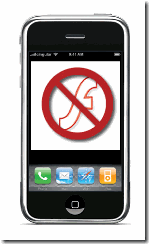In my last blog post, I discussed how I had resigned myself to the fact that the Adobe Flash Player will never be deployed on the iPhone†. 
However, that is not much use if you, as an e-learning professional, have an audience for knowledge- and content delivery via mobile devices including the iPhone. In this series of articles, I will discuss approaches to delivering training via PDAs like the iPhone based on applications and functionality already available on that device. Let’s see what happens after that.
Let’s set the context. There are a growing number of extensions to the well-established core term ‘E-Learning’ including this list of candidates (compiled in 2008 by CramerSweeney):
- C-Learning - learning via collaboration with co-workers and associates
- M-Learning - learning via a portable digital media device
- V-Learning - learning inside a virtual world (such as Second Life)
- G-Learning - learning via computer games
The latest term I have discovered is Ubiquitous Learning, or U-Learning, first discussed by Gary Woodill in his excellent Workplace Learning Today column, who encountered the term in the title of a Masters dissertation called The dawn of uLearning: near-future directions for 21st century educators). Can we now take this trend to its logical conclusion and define
- T-Learning - learning via reading educational books, academic and other Textual material
- S-Learning - learning via lecturers & teachers Speaking
- W-Learning - learning via the medium of pen, paper, and taking Written notes

[Image courtesy Flickr user tryingtimes]
‘X’ is one of the cooler letters – let’s have X-Learning. I’ll send a Mars Bar to the person who contributes the best definition of X-Learning.
Or should we stop. Now. Please.
In my view, each of these descriptors implies that the alphabetti-spaghetti of C- G- M- V-Learning activities are discrete verticals or silos, standing alone and untouched by their siblings.
Of course this is not the case: if anything, we can say that each of these terms describes a learning channel that relies on or emphasizes one modality of learning, but doesn’t - I would assert can’t – occlude other learning modalities.
So whither M-Learning among this cacophony of uppercase modifiers? Does what we commonly call ‘M-Learning’ deserve to be treated as a domain in it’s own right? Can we discover if there are any unique characteristics that differentiate learning via mobile technologies?
I think we need to take a step back. First of all, what is learning? I would assert that learning is
The acquisition of new knowledge, behaviors, skills, values, preferences or understanding, and may involve synthesizing different types of information. The progress of this acquisition over time tends to follow learning curves. Learning is a Constructivist activity.
Harold Stolovitch puts it succinctly in his 2002 text Telling Ain’t Training when he says that “learning is change, adaptation” (p.18). According to the author, we use training, instruction and education as strategies to enable people to learn.
--
†Probably.
Apple has a habit of denying that they are developing a range of devices and technologies. Right up to the moment that Apple announce their newest gizmo / solution / partnership. Until 2009 this typically occurred at an Apple Expo event with Steve Jobs uttering the famous phrase “One more thing…” as the latest object of geeky desire walks up the aisle of the technological Chapel O’ Love.
Next time: What is E-Learning (Slight Return)
Coming up: What is M-Learning?
_________________________
References:
Nalder, J. (2008). The dawn of uLearning: near-future directions for 21st century educators. Unpublished Master’s thesis, Queensland University of Technology, Brisbane. [Internet] Available from: http://www.scribd.com/doc/12398804/The-dawn-of-uLearning-Jonathan-Nalder-Masters-thesis Accessed 18th February 2009
Stolovitch, H. (2002) Telling Ain't Training. ASTD Press.
Sweeney, J. (2008) Let's Talk Terminology CramerSweeney Training Blog [Internet] Available from: http://www.cramersweeney.com/cs_id/trainingblog/ Accessed 17th February 2009
--





3 comments:
Hey Michael. Don't shoot the messenger! I was posting about a Masters thesis by Jonathan Nalder that used uLearning in the title. I agree that adding an adjective in front of the word learning doesn't create a new form of learning. My favourite example of this abuse is a 2004 conference paper on "a butterfly-watching learning" system.
Citation:
Yuh-Shyan Chen, Tai-Chien Kao, Gwo-Jong Yu, Jang-Ping Sheu, "A Mobile Butterfly-Watching Learning System for Supporting Independent Learning," wmte,pp.11, 2nd IEEE International Workshop on Wireless and Mobile Technologies in Education (WMTE'04), 2004
Hi Gary,
No messenger assassination intended! I'll modify the text of the blog to clarify that I discovered the term via your site, and that you have absolutely noting to do with the creation of the term.
I've sourced that paper you cited and I intend to read it over the next day or so.
Michael
--
BTW Gary - you didn't submit an entry for the best definition of X-Learning. Butterfly-Watching Learning doesn't count...
Post a Comment